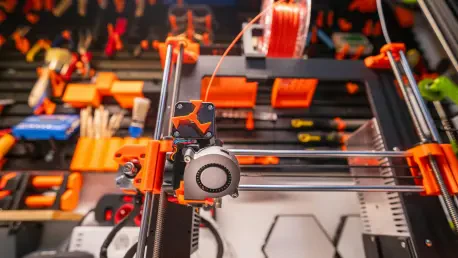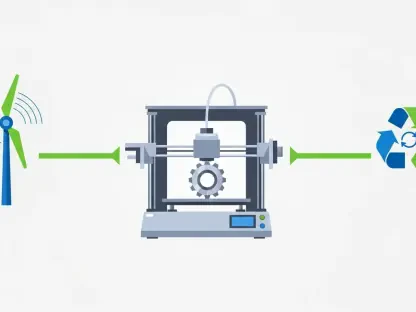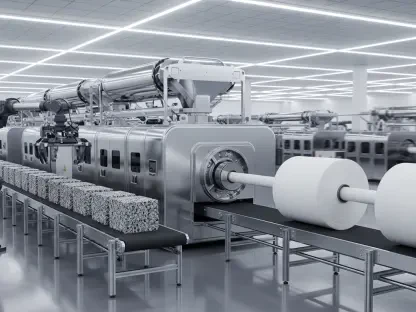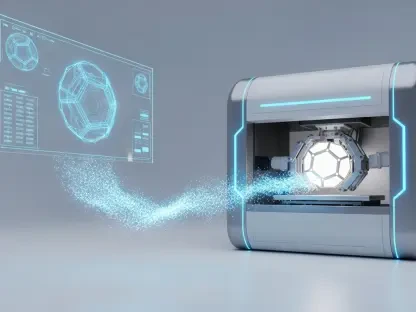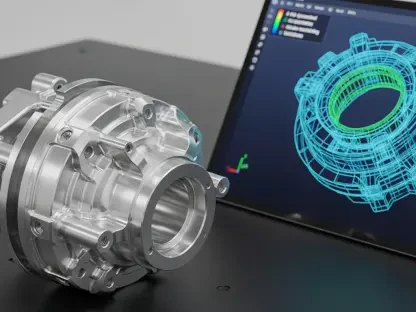Imagine a world where electronic devices are no longer confined to flat, rigid circuit boards, but instead seamlessly integrate into the curves and contours of everyday objects, from car dashboards to medical implants, marking a revolutionary shift in design. This isn’t a distant vision but a tangible reality unfolding within the realm of 3D and additive electronics manufacturing. A comprehensive report recently added to a leading research platform delves into this transformative industry, projecting its evolution from 2026 to 2036. It offers a strategic blueprint for stakeholders—manufacturers, investors, and technology developers—who are navigating a landscape where innovation is breaking traditional boundaries. The focus spans three groundbreaking segments: electronics on 3D surfaces, in-mold electronics (IME), and fully additive 3D printed electronics, each promising to redefine how functionality meets form across diverse sectors.
This market represents a paradigm shift, moving beyond the limitations of conventional two-dimensional designs to enable miniaturization, customization, and enhanced integration. Industries such as automotive, healthcare, and consumer electronics stand poised to benefit immensely, driven by a relentless push for lightweight and compact solutions. Yet, challenges like high production costs and technical hurdles in achieving fine resolution loom large. The report meticulously addresses these issues, mapping out growth trajectories and technological advancements that could shape the next decade. For anyone invested in the future of electronics, this analysis serves as a critical guide to understanding the opportunities and obstacles ahead.
Evolving Technologies and Market Segments
Shaping Electronics on 3D Surfaces
The application of electronics onto three-dimensional surfaces marks a significant leap in manufacturing flexibility, utilizing techniques such as laser direct structuring (LDS) and aerosol printing. These methods stand out for their precision in creating conductive traces on complex geometries, making them ideal for automotive components like sensor housings and antenna systems. LDS, in particular, excels by enabling intricate patterns on plastic parts, reducing assembly steps and enhancing design freedom. Materials play a pivotal role, with conductive inks and adhesives being benchmarked for performance under varying conditions. This segment has already seen commercial success in specific applications, highlighting its readiness for broader adoption across industries seeking innovative solutions.
Beyond the technical prowess, electronics on 3D surfaces offer a practical bridge between traditional and additive methods, catering to manufacturers looking to streamline production without sacrificing quality. Applications extend into consumer products and industrial equipment, where the ability to integrate electronics directly onto curved or irregular surfaces eliminates the need for bulky external components. The report emphasizes how this approach simplifies supply chains and cuts down on material waste, aligning with sustainability goals. However, achieving cost competitiveness with conventional manufacturing remains a sticking point, prompting ongoing research into scalable processes and affordable materials to drive wider market penetration.
Revolutionizing with In-Mold Electronics (IME)
In-mold electronics (IME) represent a groundbreaking convergence of molding and circuitry, embedding electronic functions directly into plastic components during the injection molding process. This eliminates the reliance on traditional printed circuit boards, offering a sleek, integrated solution for automotive human-machine interfaces (HMIs) and consumer electronics. Touch-sensitive surfaces with built-in lighting or haptic feedback are becoming increasingly common, particularly in car interiors and white goods. The technology leverages specialized conductive inks and transparent materials like carbon nanotube (CNT) films to ensure seamless functionality, as detailed in the market analysis.
The potential of IME lies in its ability to merge aesthetics with utility, creating products that are both visually appealing and highly functional. The report outlines the manufacturing intricacies, including the need for compatibility between substrates and thermoplastics to withstand molding conditions. Key challenges include ensuring durability and consistent performance over time, especially in harsh environments like automotive settings. Strategies for implementation focus on refining material formulations and optimizing production workflows to reduce defects. As adoption grows, IME is poised to transform user interactions with everyday devices, making interfaces more intuitive and space-efficient across multiple sectors.
Pioneering Fully Additive 3D Printed Electronics
Fully additive 3D printed electronics embody the ultimate vision of distributed manufacturing, where entire functional devices are created layer by layer through additive processes like 3D inkjet printing. Though still in the early stages of commercialization, this segment holds immense promise for rapid prototyping and crafting geometries unattainable with conventional methods. Applications span medical devices, sensors, antennas, and even batteries, showcasing the versatility of this approach. The technology’s ability to produce customized, on-demand solutions could disrupt traditional supply chains, as highlighted in the forecast.
However, significant hurdles remain in achieving the high resolution required for microelectronics and managing thermal issues during printing. The report dives into these technical barriers, noting that current limitations often restrict the segment to niche, low-volume applications. Material requirements are stringent, demanding advanced conductive compounds and substrates that can endure operational stresses. Progress in this area hinges on innovation in printing hardware and software to enhance precision and speed. As these challenges are addressed, fully additive 3D printing could unlock unprecedented design freedom, paving the way for a future where electronics are as unique as the objects they inhabit.
Market Dynamics and Future Outlook
Driving Growth Through Applications and Trends
The 3D and additive electronics market is propelled by application-driven demand, with automotive leading the charge due to the rise of electric and autonomous vehicles requiring lightweight, integrated components like sensors and steering wheel interfaces. Healthcare is another high-growth area, with personalized medical devices and wearables benefiting from the customization potential of additive methods. Consumer electronics, including IoT devices and smart gadgets, also contribute significantly, fueled by the need for compact and innovative designs. The market projections from 2026 to 2036 underscore how each sector’s unique requirements shape technology adoption and investment priorities.
Beyond specific industries, broader trends are shaping the market’s trajectory, notably the maturation of hybrid manufacturing that combines additive and traditional techniques for optimal scalability. Artificial intelligence (AI) integration into 3D printing processes is transforming production by enhancing design accuracy and minimizing material waste through real-time optimization. Material science advancements, such as thermally stable polymers and multifunctional composites, further expand the capabilities of 3D electronics, enabling them to meet diverse performance demands. These developments collectively signal a market moving toward greater efficiency and tailored solutions, setting the stage for widespread impact over the coming decade.
Navigating Challenges and Seizing Opportunities
Despite the promise, significant barriers hinder the mass adoption of 3D and additive electronics, including the high cost of production compared to traditional manufacturing methods. Resolution limitations for intricate microelectronics and concerns over long-term reliability in demanding environments pose additional challenges, particularly for high-stakes applications in automotive and healthcare. The analysis consolidates these issues, offering strategic insights into achieving cost parity through economies of scale and improving technical performance via enhanced materials and processes. Addressing these obstacles is critical to unlocking the market’s full potential.
On the flip side, abundant opportunities await in niche and emerging markets, such as biocompatible implants for healthcare and sustainable electronics aligning with environmental priorities. The automotive sector remains a powerhouse, driven by trends in electric vehicle production that demand innovative, lightweight components. Customer segmentation and adoption patterns are meticulously mapped to help stakeholders identify high-priority use cases for market entry. The report suggests that focusing on specific verticals with clear value propositions—such as customized medical solutions or integrated automotive systems—can accelerate growth and establish competitive advantages in this dynamic landscape.
Competitive Landscape and Strategic Pathways
Key Players and Collaborative Strategies
The competitive arena of 3D and additive electronics is vibrant, with leading companies like DuPont, Henkel, and Covestro shaping the market through technological innovation and strategic positioning. Detailed profiles of 42 key players reveal their strengths, ranging from advanced material development to cutting-edge printing technologies. Partnerships across the value chain emerge as a critical success factor, enabling firms to combine expertise in materials, manufacturing, and application development. Investment trends also paint a picture of a market ripe for funding, with financial dynamics influencing how companies scale and compete.
Collaboration extends beyond individual firms to encompass broader industry alliances, fostering innovation through shared research and development initiatives. The analysis highlights how such cooperative efforts can mitigate risks associated with high R&D costs and accelerate the commercialization of new technologies. Value chain optimization is another focal point, ensuring that raw material suppliers, equipment manufacturers, and end-users align to streamline production. This comprehensive view of competitive strategies equips stakeholders with the knowledge to navigate a crowded field, emphasizing the importance of agility and foresight in maintaining a market edge.
Forecasting Revenue and Planning Ahead
Market forecasts spanning 2026 to 2036 project robust growth, with automotive applications dominating due to their demand for integrated, lightweight electronics in next-generation vehicles. Niche sectors like healthcare show rapid expansion potential through personalized devices, while industrial IoT and white goods contribute steady increases driven by automation and smart technology needs. These revenue projections, broken down by technology types such as IME and fully additive printing, provide actionable data for prioritizing investments and development efforts in high-growth areas.
Strategic planning benefits immensely from end-user analysis, which uncovers decision-making factors like performance reliability, cost efficiency, and scalability influencing adoption rates. The report offers a roadmap for stakeholders to align their offerings with market demands, whether by targeting specific industries or refining technology to address persistent challenges. As the market evolves, success will depend on the ability to anticipate shifts in customer preferences and technological capabilities, ensuring that innovations deliver tangible value. This forward-looking perspective is essential for anyone aiming to capitalize on the transformative potential of 3D and additive electronics.
Reflecting on Transformative Insights
Looking back, the exploration of 3D and additive electronics revealed a market that stood at a pivotal juncture, brimming with potential yet tempered by significant challenges. The journey through various segments—from electronics on 3D surfaces to fully additive printing—showcased how far the industry had come in redefining design and manufacturing norms. Hybrid approaches and AI-driven optimizations had begun to bridge gaps between innovation and practicality, while material advancements had expanded application horizons across automotive, healthcare, and beyond. The competitive landscape, marked by strategic collaborations, had underscored the power of collective progress in overcoming barriers.
For the path forward, stakeholders were encouraged to prioritize targeted innovation, focusing on resolving cost and reliability issues through scalable solutions and advanced materials. Building robust partnerships across the value chain was seen as vital to accelerating adoption and sharing the risks of pioneering technologies. Additionally, keeping a close eye on emerging niches like sustainable electronics and bio-integrated devices offered a chance to lead in untapped markets. By aligning strategies with detailed forecasts and customer insights, the industry could transform these insights into actionable outcomes, ensuring that the promise of 3D electronics became a widespread reality in the years that followed.
